Dipankar Maity
Communication-aware Hierarchical Map Compression of Time-Varying Environments for Mobile Robots
Apr 14, 2025Abstract:In this paper, we develop a systematic framework for the time-sequential compression of dynamic probabilistic occupancy grids. Our approach leverages ideas from signal compression theory to formulate an optimization problem that searches for a multi-resolution hierarchical encoder that balances the quality of the compressed map (distortion) with its description size, the latter of which relates to the bandwidth required to reliably transmit the map to other agents or to store map estimates in on-board memory. The resulting optimization problem allows for multi-resolution map compressions to be obtained that satisfy available communication or memory resources, and does not require knowledge of the occupancy map dynamics. We develop an algorithm to solve our problem, and demonstrate the utility of the proposed framework in simulation on both static (i.e., non-time varying) and dynamic (time-varying) occupancy maps.
InterQ: A DQN Framework for Optimal Intermittent Control
Apr 12, 2025



Abstract:In this letter, we explore the communication-control co-design of discrete-time stochastic linear systems through reinforcement learning. Specifically, we examine a closed-loop system involving two sequential decision-makers: a scheduler and a controller. The scheduler continuously monitors the system's state but transmits it to the controller intermittently to balance the communication cost and control performance. The controller, in turn, determines the control input based on the intermittently received information. Given the partially nested information structure, we show that the optimal control policy follows a certainty-equivalence form. Subsequently, we analyze the qualitative behavior of the scheduling policy. To develop the optimal scheduling policy, we propose InterQ, a deep reinforcement learning algorithm which uses a deep neural network to approximate the Q-function. Through extensive numerical evaluations, we analyze the scheduling landscape and further compare our approach against two baseline strategies: (a) a multi-period periodic scheduling policy, and (b) an event-triggered policy. The results demonstrate that our proposed method outperforms both baselines. The open source implementation can be found at https://github.com/AC-sh/InterQ.
On Model Protection in Federated Learning against Eavesdropping Attacks
Apr 02, 2025Abstract:In this study, we investigate the protection offered by federated learning algorithms against eavesdropping adversaries. In our model, the adversary is capable of intercepting model updates transmitted from clients to the server, enabling it to create its own estimate of the model. Unlike previous research, which predominantly focuses on safeguarding client data, our work shifts attention protecting the client model itself. Through a theoretical analysis, we examine how various factors, such as the probability of client selection, the structure of local objective functions, global aggregation at the server, and the eavesdropper's capabilities, impact the overall level of protection. We further validate our findings through numerical experiments, assessing the protection by evaluating the model accuracy achieved by the adversary. Finally, we compare our results with methods based on differential privacy, underscoring their limitations in this specific context.
Communication-Aware Iterative Map Compression for Online Path-Planning
Mar 13, 2025Abstract:This paper addresses the problem of optimizing communicated information among heterogeneous, resource-aware robot teams to facilitate their navigation. In such operations, a mobile robot compresses its local map to assist another robot in reaching a target within an uncharted environment. The primary challenge lies in ensuring that the map compression step balances network load while transmitting only the most essential information for effective navigation. We propose a communication framework that sequentially selects the optimal map compression in a task-driven, communication-aware manner. It introduces a decoder capable of iterative map estimation, handling noise through Kalman filter techniques. The computational speed of our decoder allows for a larger compression template set compared to previous methods, and enables applications in more challenging environments. Specifically, our simulations demonstrate a remarkable 98% reduction in communicated information, compared to a framework that transmits the raw data, on a large Mars inclination map and an Earth map, all while maintaining similar planning costs. Furthermore, our method significantly reduces computational time compared to the state-of-the-art approach.
Multi-agent Task-Driven Exploration via Intelligent Map Compression and Sharing
Mar 21, 2024



Abstract:This paper investigates the task-driven exploration of unknown environments with mobile sensors communicating compressed measurements. The sensors explore the area and transmit their compressed data to another robot, assisting it in reaching a goal location. We propose a novel communication framework and a tractable multi-agent exploration algorithm to select the sensors' actions. The algorithm uses a task-driven measure of uncertainty, resulting from map compression, as a reward function. We validate the efficacy of our algorithm through numerical simulations conducted on a realistic map and compare it with two alternative approaches. The results indicate that the proposed algorithm effectively decreases the time required for the robot to reach its target without causing excessive load on the communication network.
Communication-Aware Map Compression for Online Path-Planning
Sep 23, 2023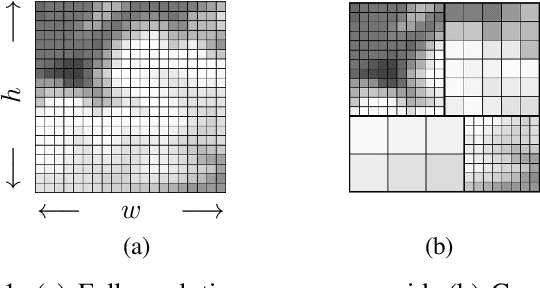
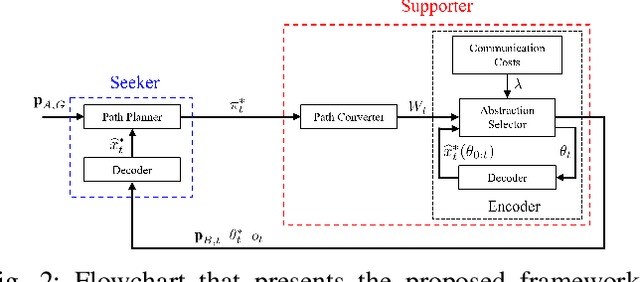
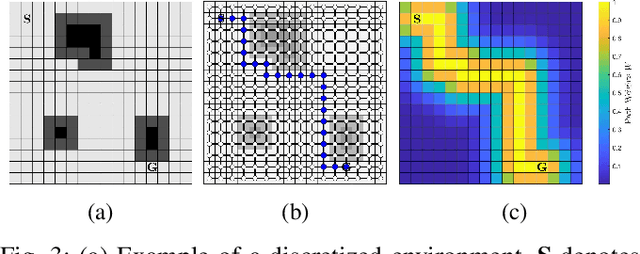
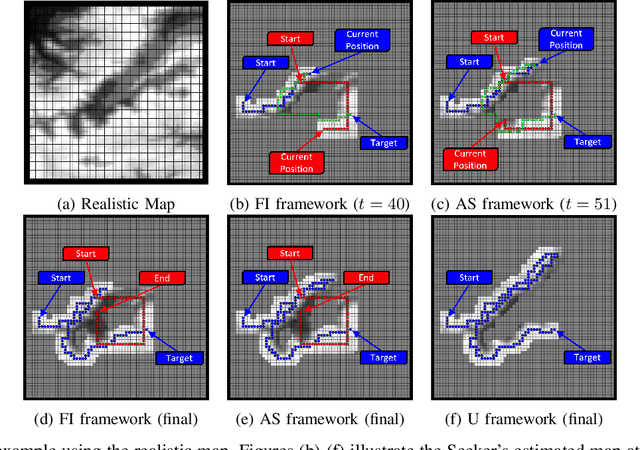
Abstract:This paper addresses the problem of the communication of optimally compressed information for mobile robot path-planning. In this context, mobile robots compress their current local maps to assist another robot in reaching a target in an unknown environment. We propose a framework that sequentially selects the optimal compression, guided by the robot's path, by balancing the map resolution and communication cost. Our approach is tractable in close-to-real scenarios and does not necessitate prior environment knowledge. We design a novel decoder that leverages compressed information to estimate the unknown environment via convex optimization with linear constraints and an encoder that utilizes the decoder to select the optimal compression. Numerical simulations are conducted in a large close-to-real map and a maze map and compared with two alternative approaches. The results confirm the effectiveness of our framework in assisting the robot reach its target by reducing transmitted information, on average, by approximately 50% while maintaining satisfactory performance.
Target Defense against Periodically Arriving Intruders
Mar 09, 2023Abstract:We consider a variant of pursuit-evasion games where a single defender is tasked to defend a static target from a sequence of periodically arriving intruders. The intruders' objective is to breach the boundary of a circular target without being captured and the defender's objective is to capture as many intruders as possible. At the beginning of each period, a new intruder appears at a random location on the perimeter of a fixed circle surrounding the target and moves radially towards the target center to breach the target. The intruders are slower in speed compared to the defender and they have their own sensing footprint through which they can perfectly detect the defender if it is within their sensing range. Considering the speed and sensing limitations of the agents, we analyze the entire game by dividing it into partial information and full information phases. We address the defender's capturability using the notions of engagement surface and capture circle. We develop and analyze three efficient strategies for the defender and derive a lower bound on the capture fraction. Finally, we conduct a series of simulations and numerical experiments to compare and contrast the three proposed approaches.
Planning Visual Inspection Tours for a 3D Dubins Airplane Model in an Urban Environment
Jan 12, 2023Abstract:This paper investigates the problem of planning a minimum-length tour for a three-dimensional Dubins airplane model to visually inspect a series of targets located on the ground or exterior surface of objects in an urban environment. Objects are 2.5D extruded polygons representing buildings or other structures. A visibility volume defines the set of admissible (occlusion-free) viewing locations for each target that satisfy feasible airspace and imaging constraints. The Dubins traveling salesperson problem with neighborhoods (DTSPN) is extended to three dimensions with visibility volumes that are approximated by triangular meshes. Four sampling algorithms are proposed for sampling vehicle configurations within each visibility volume to define vertices of the underlying DTSPN. Additionally, a heuristic approach is proposed to improve computation time by approximating edge costs of the 3D Dubins airplane with a lower bound that is used to solve for a sequence of viewing locations. The viewing locations are then assigned pitch and heading angles based on their relative geometry. The proposed sampling methods and heuristics are compared through a Monte-Carlo experiment that simulates view planning tours over a realistic urban environment.
* 18 pages, 10 figures, Presented at 2023 SciTech Intelligent Systems in Guidance Navigation and Control conference
Target Defense against Sequentially Arriving Intruders
Dec 13, 2022

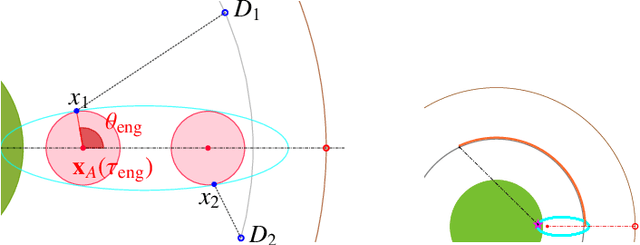

Abstract:We consider a variant of the target defense problem where a single defender is tasked to capture a sequence of incoming intruders. The intruders' objective is to breach the target boundary without being captured by the defender. As soon as the current intruder breaches the target or gets captured by the defender, the next intruder appears at a random location on a fixed circle surrounding the target. Therefore, the defender's final location at the end of the current game becomes its initial location for the next game. Thus, the players pick strategies that are advantageous for the current as well as for the future games. Depending on the information available to the players, each game is divided into two phases: partial information and full information phase. Under some assumptions on the sensing and speed capabilities, we analyze the agents' strategies in both phases. We derive equilibrium strategies for both the players to optimize the capture percentage using the notions of engagement surface and capture circle. We quantify the percentage of capture for both finite and infinite sequences of incoming intruders.
A Linear Programming Approach for Resource-Aware Information-Theoretic Tree Abstractions
Aug 08, 2022
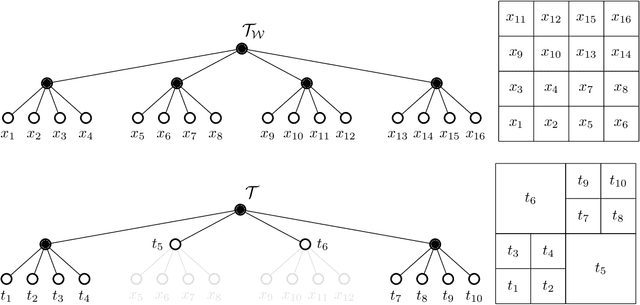
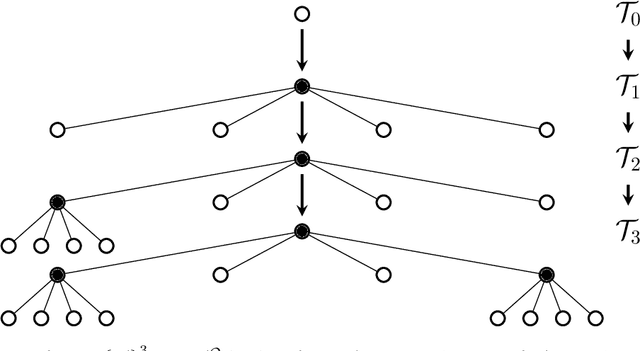
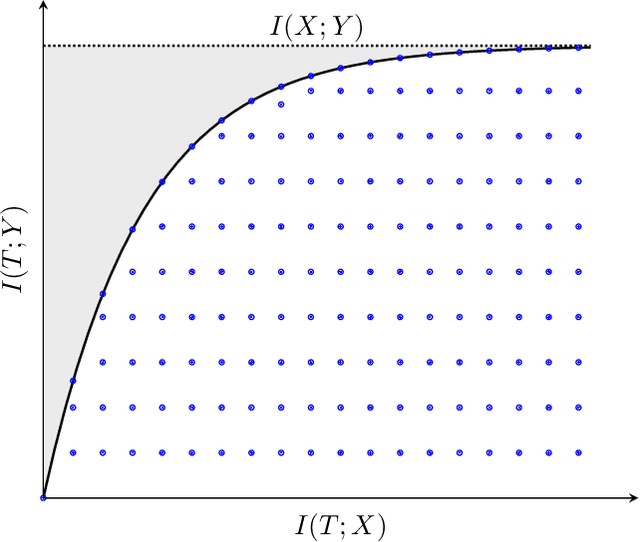
Abstract:In this chapter, an integer linear programming formulation for the problem of obtaining task-relevant, multi-resolution, environment abstractions for resource-constrained autonomous agents is presented. The formulation leverages concepts from information-theoretic signal compression, specifically, the information bottleneck (IB) method, to pose an abstraction problem as an optimal encoder search over the space of multi-resolution trees. The abstractions emerge in a task-relevant manner as a function of agent information-processing constraints. We detail our formulation, and show how hierarchical tree structures, signal encoders, and information-theoretic methods for signal compression can be unified under a common theme. A discussion delineating the benefits and drawbacks of our formulation is presented, as well as a detailed explanation how our approach can be interpreted within the context of generating abstractions for resource-constrained autonomous systems. It is shown that the resulting information-theoretic abstraction problem over the space of multi-resolution trees can be formulated as a integer linear programming (ILP) problem. We demonstrate the approach on a number of examples, and provide a discussion detailing the differences of the proposed framework compared to existing methods. Lastly, we consider a linear program relaxation of the ILP problem, thereby demonstrating that multi-resolution information-theoretic tree abstractions can be obtained by solving a convex program.
 Add to Chrome
Add to Chrome Add to Firefox
Add to Firefox Add to Edge
Add to Edge